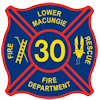SMOKE DETECTORS SAVES LIVES
The majority of fatal home fires happen at night, when people are asleep. Contrary to popular belief, the smell of smoke may not wake a sleeping person. The poisonous gases and smoke produced by a fire can numb the senses and put you into a deeper sleep.
Inexpensive household smoke detectors sound an alarm, alerting you to a fire. By giving you time to escape, smoke detectors cut your risk of dying in a home fire, nearly in half. Smoke detectors save so many lives that most states have laws requiring them in private homes.
CHOOSING A DETECTOR
Be sure that the smoke detectors you buy carry the label of an independent testing laboratory.
Several types of detectors are available. Some run on batteries, others on household current. Some detect smoke using an “ionization” sensor, other use a “photoelectric” detection system. All approved smoke detectors, regardless of the type, will offer adequate protection provided they are installed and maintained properly.
IS ONE ENOUGH?
Every home should have a smoke detector outside each sleeping area and on every level of the home, including the basement. The National Fire Alarm Code, developed by NFPA, requires a smoke detector in each sleeping room for new construction. On floors without bedrooms, detectors should be installed in or near living areas, such as dens, living rooms, or family rooms.
Be sure everyone sleeping in your home can hear your smoke detectors’ alarms. If any residents are hearing-impaired or sleep with bedroom doors closed, install additional detectors inside sleeping areas as well. There are special smoke detectors for the hearing impaired; these flash a light in addition to sounding an audible alarm.
For extra protection, NFPA suggests installing detectors in dining rooms, furnace rooms, utility rooms, and hallways. Smoke detectors are not recommended for kitchens, bathrooms, or garages where cooking fumes, steam, or exhaust fumes could set off false alarms – or for attics and other unheated spaces where humidity and temperature changes might affect a detector’s operation.
WHERE TO INSTALL?
Because smoke rises, mount detectors high on a wall or on the ceiling. Wall-mounted units should be mounted so that the top the the detector is 4 to 12 inches (10 to 30cm) from the ceiling. A ceiling-mounted detector should be attached at least 4 inches (10cm) from the near east wall. In a room with a pitched ceiling, mount the detector at or near the ceiling’s highest point.
In stairways with no doors at the top or bottom, position smoke detectors anywhere in the path of smoke moving up the stairs. But always position smoke detectors at the bottom of closed stairways, such as those leading to the basement, because dead air trapped near the door at the top of a stairway could prevent smoke from reaching a detector located at the top.
Don’t install a smoke detector too near a window, door, or forced-air register where drafts could interfere with the detector’s operation.
INSTALLATION
Most battery-powered smoke detectors and detectors that plug into wall outlets can be installed using only a drill and a screwdriver, by following the manufacturer’s instructions. Plug-in detectors must have restraining devices so they cannot be unplugged by accident. Detectors can also be hard-wired into a building’s electrical system. Hard-wired detectors should be installed by a qualified electrician. Never connect a smoke detector to a circuit that can be turned off by a wall switch.
FALSE ALARMS
Cooking vapors and steam sometimes set off a smoke detector. To correct this, try moving the detector away from the kitchen or bathroom, or install an exhaust fan. Cleaning your detector regularly, according to the manufacturer’s instructions, may also help.
If “nuisance alarms” persist, do not disable the detector. Replace the detector.
MAINTENANCE
Only a functioning smoke detector can protect you. Never disable a detector by “borrowing” its battery for another use.
Following the manufacturer’s instructions, test all your smoke detectors monthly and install new batteries at least once a year. A good reminder is when you change your clocks in the spring or fall: change your clock, change your battery.
Clean you smoke detectors using a vacuum cleaners without removing the detector’s cover.
Never paint a smoke detector.
Smoke detectors don’t last forever. Replace any smoke detector that is more than 10 years old.
CHECKLIST
Make sure everyone is familiar with the sound of the detector’s alarm.
Plan escape routes. Know at least two ways out of each room. Agree on a meeting place outside your home where all residents will gather after they escape. Practice your escape plan at least twice a year.
Remove obstructions from doors and windows needed for escape.
Make sure everyone in the household can unlock doors and windows quickly, even in the dark. Windows or doors with security bars should be equipped with quick-release devices, and everyone in the household should know how to use them.
When an alarm sounds, leave immediately. Go directly to your outside meeting place and call the fire department.
Once you’re out, stay out. Never return to a burning building.
People Protecting People Since 1896
Copyright 1995
National Fire Protection Association
Batterymarch Park
Quincy, MA 02269-9101
